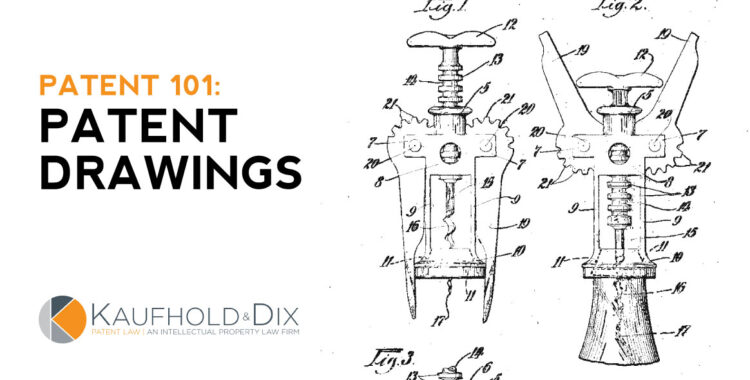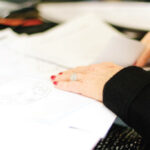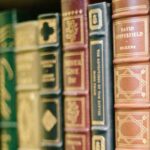Patent 101 – The Basics of Patent Drawings
By definition, patents are novel legal arrangements describing a new and non-obvious embodiment of an idea. To obtain a patent, the inventor must apply to the patent office, and one of the relevant, supporting sections of a patent application are the patent drawings. The drawings of a patent application assist the Patent Examiner in understanding an invention as spelled out by the specification and therefore provide a visual understanding of what is being protected with the words that are used in the claims of the application. Because they are relied upon by the USPTO to better grasp the idea, there are guidelines to which the drawings much adhere.
Intellectual Property Playbook
An Entrepreneur's Guide To Patents, Trademarks, and Copyrights GET THE PLAYBOOK
Guidelines for Patent Drawings
The primary formatting rules for patent drawing are as follows (for more details, check the USPTO drawing guidelines):
- First and foremost – there are typically no re-do’s when it comes to patent drawings. Because a patent application cannot be amended to add new matter once it is filed, it is nearly impossible to fix defective drawings since any corrections would inherently add new matter. They must be correct when filed.
- Colored drawings are generally not allowed. There is an exception for this rule in case the color is particularly important in explaining the invention or where a photo is required to better show an invention or the results of an experiment.
- Photographs are only allowed in case there is no realistic way of conveying the details of the invention.
- The drawings should have multiple views to explain the invention accurately. In some inventions, exploded views, cross-sections, and blown-up partial views for specific parts of the invention are helpful. While providing multiple viewpoints, the drawings will most often be grouped with one another and face in one direction on the drawing paper.
- The drawing scale of the patent drawing should allow viewing of the details discussed in the patent application with the understanding they may be reduced in size during reproduction. Any details blurred in case of size reduction or are otherwise difficult to view will elicit an objection from the USPTO.
- Shading the drawings is allowed, especially if shading will help in depicting the invention.
- Both numbers and alphabets are allowed on the drawing, although numbers are more preferred. In case the alphabet is used, the U.S. patent office permits only English alphabets.
- The ink should be black.
- The paper should be white, pliable, muted in appearance (should not be shiny), and robust. The size of the paper is also standardized. The required dimensions are 12cm by 29.7cm or 27.9 cm by 21.6 cm. Currently, double-sided paper use is not allowed and inventors are allowed to use only one side of the drawing paper.
- The margins of the drawings paper must be uniform throughout the application. The required margins are 2.5 cm for the top margin, 2.5 cm for the left margin, 1.5 cm for the right margin, and 1 cm for the bottom margin.
- Design patent drawings require exactness since is it the drawings that the resulting patent will ultimately protect.
- Utility patent drawings are only examples of what the invention might look like since it is the words that are protected. However, the drawings must still be complete and correct and any structure mentioned within the claims of the application must be shown in the drawings or that structure must be removed.
Hiring A Professional Artist
Typically an inventor will hire a professional who understands the USPTO requirements and is adept at drafting mechanical drawings. Hiring a drafter can become expensive with some drafters charging up to $150 per page. With most patent applications utilizing at a minimum of 5 or 6 drawings, the costs can quickly become burdensome. Kaufhold & Dix Patent Law removes that concern by incorporating the drafting into the overall flat fee of a patent application.
If your budget allows, a professional artist is recommended.
Do-It-Yourself Patent Drawings
Though professional renderings will likely be needed for filing a patent application, it is still useful for the inventor to attempt to draw the invention as well. This will give the inventor the opportunity to not only better understand their own invention, as well give insight into helpful modifications, drafts completed by inventors can be used by the professional draftsperson to create filing-worthy drawings. The draftsperson will also typically have at their disposal a write-up of the features of the invention that can be used to supplement any drawings provided by the inventor.
Computer software, such as Computer-Aided Designs Drawings, can often be learned and used by laypersons to at least attempt rudimentary drawings – should the inventor not wish to create drawings freehand. The software comes in handy in case the inventor believes the hand-drawn drawings will not be helpful. Moreover, the drawing software can create perfect shapes and 3D images that will help describe and break down the physical characteristics of the invention. The drawings are also easy to correct since they can be easily modified and saved. Finally, these saved files can be used by the professional draftsperson as a starting point for final drawings.
It is essential to know that some of the drawing software can be expensive. Most of the software will cost hundreds of dollars or more. Hiring a professional artist from the outset, using drawing software, or starting with a DIY draft of a patent drawing largely depends on budgets and ability. However, law firms specializing in patents such as we at Kaufhold & Dix typically always have professionals ready to assist inventors.
Final Thought
Patent drawings are a requirement for most utility patent applications, particularly those that are attempting to patent an apparatus, though drawings can further be helpful for other types of patent applications covering, for example, methods, biology, and chemistry. Incomplete or incorrect drawings can be a death knell to a patent application and great care should be taken to ensure their completeness for the patent application being considered.






